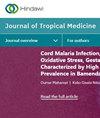Effect of Malaria and Schistosoma mansoni Coinfection on Selected Biochemical Profiles among Patients Attending Selected Health Institutions at Dembiya, Northwest Ethiopia
IF 2.1
4区 医学
Q3 PUBLIC, ENVIRONMENTAL & OCCUPATIONAL HEALTH
引用次数: 0
Abstract
Background. Malaria and schistosomiasis are infectious diseases that cause biochemical abnormalities. Malaria and Schistosoma mansoni coinfection causes exacerbations of health consequences and comorbidities. The study area is found in Ethiopia, where coinfection of malaria and S. mansoni is common. However, there is limited data on the biochemical profiles of patients coinfected with malaria and S. mansoni schistosomiasis in the study area. Hence, this study aimed to assess the effect of malaria and S. mansoni schistosomiasis coinfection on selected biochemical profiles. Methods. An institutional-based comparative cross-sectional study was conducted from March 30 to August 10, 2022. Using a convenient sampling technique, 70 participants (35 cases and 35 controls) were enrolled in the study. Schistosoma mansoni was detected in stool samples using the wet mount and the Kato Katz method. To detect Plasmodium, both thick and thin blood films were prepared and stained with Giemsa. The blood sample was processed for the analysis of biochemical profiles. All data were analyzed using SPSS version 25. A value of less than 0.05 was considered statistically significant. Results. The mean values of alanine aminotransferase and aspartate aminotransferase (37.1 U/L and 41.9 U/L, respectively) in coinfected participants were significantly higher than in the healthy control participants (17.4 U/L and 22.0 U/L, respectively) . Also, the median values of creatinine, total bilirubin, and direct bilirubin (1.51 mg/dL, 2.35 mg/dL, and 0.91 mg/dL, respectively) in coinfected participants were significantly higher than in the healthy control participants (0.85 mg/dL, 0.42 mg/dL, and 0.12 mg/dL, respectively) . However, median values of total protein (4.82 g/dL) and mean values of glucose (66.6 mg/dL) in coinfected participants were significantly lower than in the healthy control participants (total protein (7.64 g/dL) and glucose (91.9 mg/dL)) . The results of biochemical profiles in healthy participants were significantly different from those with light, moderate, and heavy S. mansoni infection intensity in malaria and S. mansoni coinfection . Schistosoma mansoni infection intensity had a positive correlation with biochemical profiles except for total protein and glucose, which correlated negatively in coinfected participants . Conclusion. Biochemical profiles in coinfection were significantly changed as compared to healthy individuals. As a result, biochemical profile tests should be utilized to monitor and manage coinfection-related problems, as well as to reduce coinfection-related morbidity and death.疟疾和曼氏血吸虫合并感染对埃塞俄比亚西北部登比亚部分医疗机构就诊患者部分生化指标的影响
背景。疟疾和血吸虫病是导致生化异常的传染病。疟疾和曼氏血吸虫合并感染会加重健康后果和合并症。研究地区位于埃塞俄比亚,那里疟疾和曼氏血吸虫合并感染很常见。然而,关于该研究地区疟疾和曼森血吸虫病合并感染患者的生化指标的数据却很有限。因此,本研究旨在评估疟疾和曼氏血吸虫病合并感染对某些生化指标的影响。研究方法于 2022 年 3 月 30 日至 8 月 10 日开展了一项以机构为基础的横断面比较研究。研究采用方便抽样技术,共招募了 70 名参与者(35 例病例和 35 例对照)。采用湿装载法和加藤卡茨法检测粪便样本中的曼氏血吸虫。为检测疟原虫,制备了厚和薄的血片,并用吉氏染色法染色。血样经处理后用于分析生化指标。所有数据均使用 SPSS 25 版进行分析。小于 0.05 的数值被认为具有统计学意义。结果合并感染者的丙氨酸氨基转移酶和天冬氨酸氨基转移酶平均值(分别为 37.1 U/L和 41.9 U/L)明显高于健康对照者(分别为 17.4 U/L和 22.0 U/L)。此外,合并感染者的肌酐、总胆红素和直接胆红素的中位值(分别为 1.51 毫克/分升、2.35 毫克/分升和 0.91 毫克/分升)也明显高于健康对照者(分别为 0.85 毫克/分升、0.42 毫克/分升和 0.12 毫克/分升)。然而,合并感染者的总蛋白中位值(4.82 克/分升)和葡萄糖平均值(66.6 毫克/分升)明显低于健康对照者(总蛋白(7.64 克/分升)和葡萄糖(91.9 毫克/分升))。在疟疾和曼氏血吸虫合并感染中,健康参与者的生化指标结果与曼氏血吸虫轻度、中度和重度感染者有明显差异。除总蛋白和葡萄糖与生化指标呈负相关外,曼氏血吸虫感染强度与生化指标呈正相关。结论与健康人相比,合并感染者的生化指标发生了显著变化。因此,应利用生化指标检测来监测和管理与合并感染相关的问题,并降低与合并感染相关的发病率和死亡率。
本文章由计算机程序翻译,如有差异,请以英文原文为准。
求助全文
约1分钟内获得全文
求助全文
来源期刊

Journal of Tropical Medicine
Immunology and Microbiology-Parasitology
CiteScore
3.90
自引率
4.50%
发文量
0
审稿时长
14 weeks
期刊介绍:
Journal of Tropical Medicine is a peer-reviewed, Open Access journal that publishes original research articles, review articles, and clinical studies on all aspects of tropical diseases. Articles on the pathology, diagnosis, and treatment of tropical diseases, parasites and their hosts, epidemiology, and public health issues will be considered. Journal of Tropical Medicine aims to facilitate the communication of advances addressing global health and mortality relating to tropical diseases.
 求助内容:
求助内容: 应助结果提醒方式:
应助结果提醒方式:


